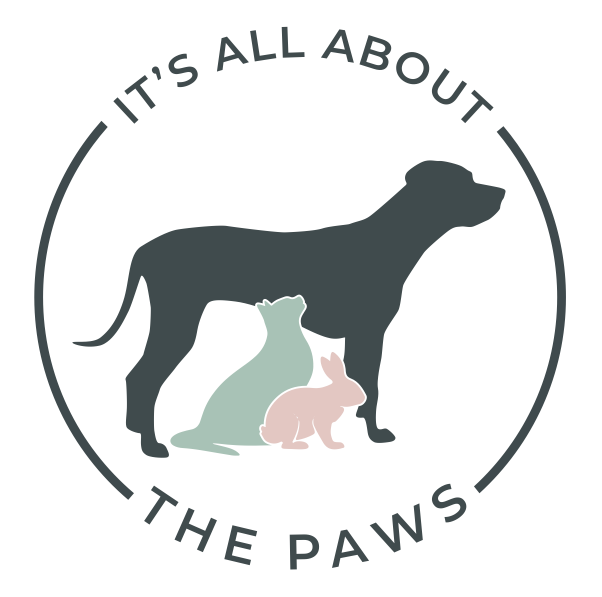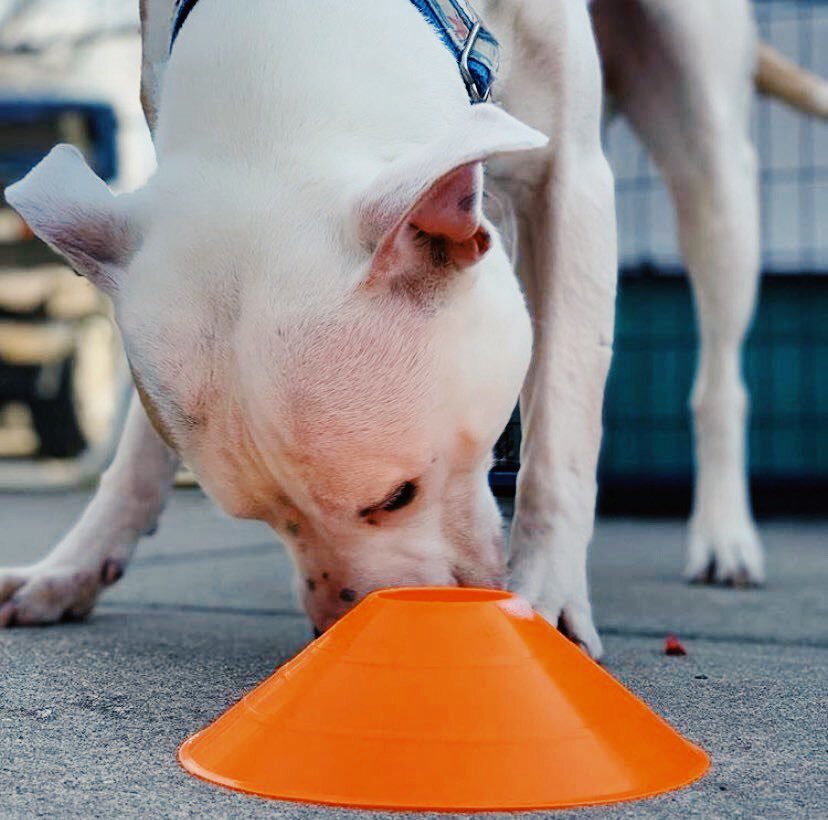Enrichment Series Part Three: Types of Enrichment
Last week we discussed that caring for our pets' mental, emotional, and physical needs can improve their behavior. You were also given a chance to work on what categories need more enrichment and thought about how to implement those changes. Now that you have that down let's discuss all the ways to enrich your dog's life!
SCENT WORK - scent work is an amazing form of enrichment, but it is also a great way to include physical activity and build confidence. If your dog loves to sniff, this is a win-win-win. Additionally, for both you and your animal, scent work is a great way to bring your relationship to the next level!
Remember a couple of weeks ago, when I mentioned there was science behind enrichment? Well, here it is, ready to blow your mind. The Olfactory Bulb is a bulb of neural tissue within your dog's brain. It is located in the fore-brain and is responsible for processing scents detected by cells in the nasal cavity. It is approximately 40 times larger in dogs than in humans, relative to total brain size. A large visual cortex dominates the human brain while the olfactory cortex dominates a dog's brain. The Olfactory Bulb accounts for one-eighth of the dog's brain. The Olfactory Bulb is extremely important to the dog due to its function of processing scent. Scent information travels from the Olfactory Bulb to the limbic system, which is the most primitive part of the brain (dealing with emotions, memory, and behavior). It also travels to the cortex, which is the outer part of the brain that has to do with conscious thought.
If your brain just exploded as I said it would, let me explain in layman terms. Scent is processed in the same place of the brain as emotion, which means for a fearful or anxious dog, scent work can help calm their fear. When we compare scent work to the enrichment chart we can help exercise them physically and mentally, we can allow them to relax or calm themselves down, we can enable them to use their instinctual behaviors, and we can give them sensory stimulation. Just this one option checks five boxes on the chart! Now that will be one happy and tired dog.
DECOMPRESSION WALKS - a decompression walk is different from a regular walk with your dog. Think about it - a regular walk is typically rushed along by us as humans and could potentially leave your dog feeling more stressed as we drag them along to get back home, so we don't miss the next episode of that addicting T.V. show. But sniffing is a species-specific behavior, and it is also a calming behavior - great for a dog dealing with stress and a great way to mentally stimulate them.
A decompression walk is either off-leash or with a long lead. I only recommend doing this during off-hours of the day and only if your dog has mastered recall. This is giving your dog the agency to sniff and explore where they would like to. During a decompression walk, you should see your dog's body language slowly start to loosen - soft face (and not soft to the touch, but soft meaning they are not tensing the muscles in their face), open mouth with a relaxed pant (a relaxed mouth is where their lips are curving and not so tense that their lips make a straight line), relaxed tail held in its natural position and overall a loose body.
As mentioned above and similar to scent work, sniffing is very relaxing to the dog as it is connected to the Olfactory Bulb and the limbic system, where emotions are processed. Your dog also has an extra scent organ on the roof of their mouth called the vomeronasal organ that helps them process scent (there's that science popping up again). Again comparing a decompression walk to our enrichment chart we can assume that we are helping them exercise both physically and mentally, we can allow them to calm themselves by sniffing, we can enable them to use their instinctual behaviors, we can allow them to exercise their independence by deciding what to explore, and we can give them sensory stimulation since they will be sniffing new smells and likely hearing new noises!
TRAINING - how can training even be enriching, you ask? Most people don't think of training your dog new tricks as enrichment, because well it might not be your typical game, but it can and will wear them out... if you do it right! In order for training to enrich your dogs mentally, you will need to figure out what it is they are willing to attain - in other words, what is their favorite reward? Is it a tennis ball or a super stinky yummy treat like some string cheese? Once you figure this out, you can use this reward to teach them new skills, and you will have a dog who is engaged and focused on you.
There is no limit to what you can teach your dog, truly. You can teach them how to use a scratchboard to trim their own nails, you can teach them how to communicate with you by using a headrest to tell you they would like something, you can teach them how to put their toys away, and the list goes on and on! However, to ensure that this experience is enriching to your dogs, you want to avoid any fear-based training, force, or pressure. This is not collaborating with your dog, this is forcing your dog into doing something, and it no longer becomes fun. You are removing the agency in this type of enrichment by forcing them.
When I was going through classes at my local shelter, the trainer had me imagine if someone forced me to sit in a room full of spiders if I was scared of them (which I am). Would I be mentally tired after? Sure - I was scared to death the whole time. But would I have fun during that experience? Heck no. Working on training with your dog will exercise them mentally without a doubt, but depending on what you are training them, you can exercise them in so many other categories of enrichment too. If you are training your dog how to use a scratchboard, you are helping create an agency for health/veterinary. If you are training a relaxation protocol, you are helping them learn how to calm down. If you are allowing them to decide when they are no longer interested in learning, you are allowing them to express their independence. You are also working on social interaction since this form of enrichment involves you! Truthfully, the list goes on and on for what categories are being worked on, and we can truly use creativity with training.
FORAGING - since our dogs' ancestors were not domesticated animals, they had to search for their food. "Foraging is the act of searching for and working to obtain food" (Canine Enrichment for The Real World, Allie Bender). Since foraging is an instinctual behavior that our dogs love to do, and honestly that we have seen them all do inappropriately - this can be a fun way to add enrichment to your dog's life. This typically is such a fun form of enrichment for dogs because all dogs are motivated by food.
You might tell me I'm crazy or wrong; however, just like us humans, dogs need to eat to survive. This could be a tangent, but since dogs need food to survive, they typically enjoy working for food. The way that I think of it is when we go to work, our reward is the paycheck at the end of every two weeks. So when a dog goes to work, they are getting paid with food when they complete the task. If your dog seems not to enjoy foraging, try adjusting the way you are doing it. Has your dog ever performed this skill before? If not, maybe the way you have it set up is too hard. Is the food you are using tasty and motivating enough? When teaching your dog this skill, use a more highly valued snack to help them learn. As they get better, you can mix in your dog's dinner, and they will continue to enjoy this skill because they are still getting paid. Just as enrichment can be an adjustment for us, there can be a learning period for our dogs, too - they might not have experience with this either! Foraging is a great way to exercise your dog mentally, check the foraging box in our enrichment chart (duh), stimulate their senses, incorporate their diet/nutrition, and even let them be independent.
As mentioned before, there is so much that goes into enrichment, and we are only scratching the surface in our blog. The sky is truly the limit with what is enriching to your dogs. For additional questions on enrichment, you can email me!
To learn more about enrichment, what types of enrichment you can implement into your dog's life, and groups to follow for inspiration, check out the following resources:
Facebook Groups - Canine Enrichment, Pet Harmony Training (Monthly Training Challenges) and Falkor and Rescue Friends.
Books - Canine Enrichment for the Real World by Allie Bender & Emily Strong
In the end, we all want our pets to be the healthiest possible and live the longest life possible, and we want to help everyones pet stay healthy and happy! The more we study and learn of better avenues, the better their diet, their health, and their overall life will become. Have a topic you'd like us to discuss? Send an email to info@itsallaboutthepaws.org.
The information discussed here has been researched and learned from: Allie Bender at Pet Harmony Training, Canine Enrichment for the Real World, Balance Behaviour, Best Friends, and other related resources.

